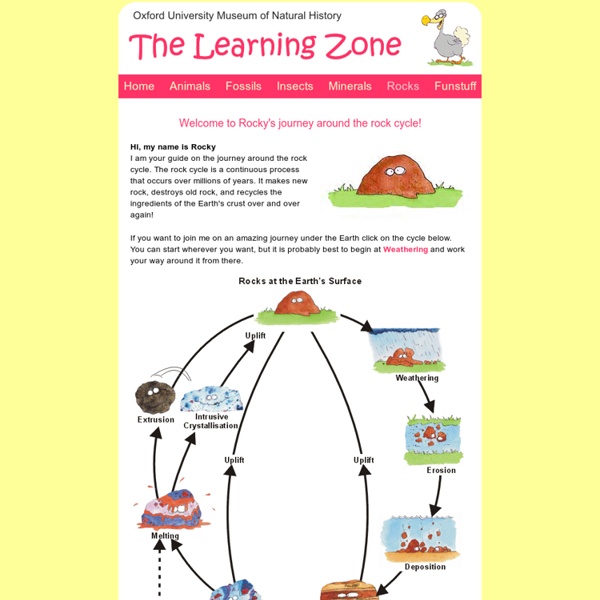



Rock Cycle The Rock Cycle Written for the KidsKnowIt Network by: Brandon Guymon There are three main types of rocks: igneous, sedimentary, and metamorphic. Each of these types of rocks are formed in different ways and each type of rock can be changed into each of the other types of rock. Geologists call this process the Rock Cycle. Most rocks on earth began as igneous rocks. Roll your mouse over the image to highlight the parts of the rock cycle. Our igneous rock has turned into a sedimentary rock. Metamorphic rocks can also be weathered and eroded and eventually changed into sedimentary rocks. An example of metamorphic rock. So let's take the process from the beginning, and find out how it works. When the plates crash into each other, geologists call this type of plate boundary a convergent boundary. In short, the rock cycle is the name for the processes that forms and recycles the different types or rocks on our planet.
Rock Key The Rock Identification Key - by Don PeckRock Key Table of Contents What Are Rocks? Rocks are what the crust of the earth is made of. They are the mountains and the bottom of the ocean. [ Return to Rock Key Table of Contents ] What Minerals Form Rocks? The rock cycle The Earth is an active planet. Earthquakes shake and volcanoes erupt. Sections of the crust are on the move. Mountains push up and wear down. These and many other processes contribute to the rock cycle, which makes and changes rocks on or below the Earth’s surface. Rocks are made of minerals, which are made of specific chemical elements. There are three main types of rock – igneous, sedimentary and metamorphic. Igneous rocks Magma is a hot mix of melted minerals, and igneous rocks are formed when it cools. Sedimentary rocks On the surface of the Earth, the processes of weathering and erosion can break down any rock into small pieces called sediments. Not all sedimentary rocks are made from broken pieces of other rocks. Metamorphic rocks The Earth’s crust is constantly, but slowly, on the move. There are parts of the Earth, called subduction zones, where the crust is carried deep inside. Interacting cycles The rock cycle interacts with other Earth cycles in many ways.
The Life Cycle of a Mineral Deposit—A Teacher’s Guide for Hands-On Mineral Education Activities This teacher's guide defines what a mineral deposit is and how a mineral deposit is identified and measured, how the mineral resources are extracted, and how the mining site is reclaimed; how minerals and mineral resources are processed; and how we use mineral resources in our every day lives. Included are 10 activitybased learning exercises that educate students on basic geologic concepts; the processes of finding, identifying, and extracting the resources from a mineral deposit; and the uses of minerals. The guide is intended for K through 12 Earth science teachers and students and is designed to meet the National Science Content Standards as defined by the National Research Council (1996). The process of finding or exploring for a mineral deposit, extracting or mining the resource, recovering the resource, also known as beneficiation, and reclaiming the land mined can be described as the “life cycle” of a mineral deposit.